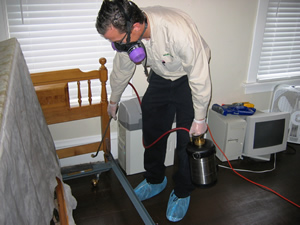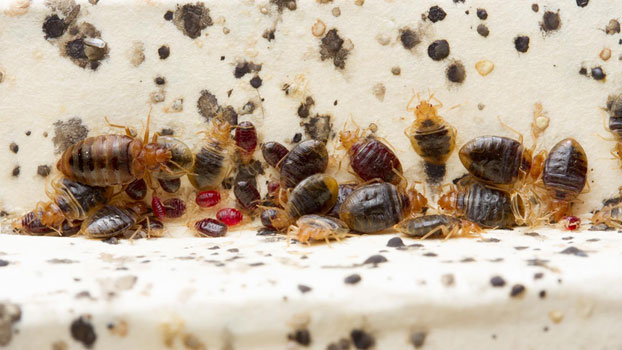Premier Bed Bug Exterminator: DC Exterminator for Effective Treatment
Premier Bed Bug Exterminator: DC Exterminator for Effective Treatment
Blog Article
Discovering the Science Behind Bed Bug Warm Treatments as a Sustainable Parasite Administration Method
In the world of pest monitoring, the pursuit for lasting and efficient services stays a constant search. One such technique that has gotten grip in the last few years is making use of warmth treatments to combat bed insect invasions. By harnessing the scientific research behind thermal fatality points for these persistent pests, warm therapies supply an encouraging alternative to standard chemical-based methods. The complexities of exactly how heat properly gets rid of bed pests and the wider ramifications for sustainable pest monitoring techniques make this a topic worth discovering better.
Bed Bug Heat Treatment Refine

Thermal Fatality Factor for Bed Bugs
Subjecting bed insects to elevated temperature levels past their thermal tolerance variety is critical for attaining efficient eradication in warm treatment procedures. By getting to and preserving temperature levels above the thermal death point for bed insects, bug management professionals can make certain detailed removal of bed pest populaces, including hard-to-reach locations where chemical therapies may be much less efficient. Understanding the thermal death point for bed pests is important for executing successful warmth treatment methods and achieving lasting insect management end results.
Advantages of Warm Treatments
Having actually established the essential thermal fatality point for bed pests, it is imperative to now explore the substantial advantages that warmth therapies use in efficiently eliminating these durable pests. Heat therapies present numerous crucial benefits when compared to traditional chemical approaches. One of the primary advantages is that warmth can penetrate deep right into cracks and gaps where bed insects conceal, making sure that even the most hard-to-reach locations are warmed to lethal temperatures. This detailed technique not only eliminates real-time pests yet additionally targets bed bug eggs, protecting against future invasions.
Furthermore, warmth treatments are safe and eco-friendly, making them a lasting bug monitoring method. Unlike chemical pesticides, warm therapies do not leave damaging deposits that can position dangers to human health or the atmosphere. This aspect is especially vital in sensitive atmospheres such as healthcare facilities, schools, and houses where chemical use may not be preferable.
Additionally, heat therapies have a high success rate in removing bed insect problems in a solitary therapy, reducing the demand for several gos to and reducing disturbance to occupants. This efficiency not just saves time and cash but additionally provides satisfaction to those managing bed bug troubles.
Performance of Heat Treatment

Warmth therapies have actually the added advantage of eliminating bed insect eggs, which are commonly immune to conventional chemical therapies. On the whole, the efficiency of warmth therapies in removing bed insect infestations makes them a sustainable and trusted bug management technique.
Lasting Parasite Management Perks
Carrying out sustainable pest administration techniques uses long-term benefits for both the setting and public wellness. By using techniques such as warm treatments for parasite control, we can decrease the dependence on damaging chemical pesticides that can have damaging impacts on environments and human health - bed bug treatment. Lasting bug administration approaches help in preserving biodiversity by targeting details pests without harming non-target organisms, thus maintaining a balanced ecosystem
Moreover, lasting pest management practices add to the total health and wellness and well-being of the public. By decreasing exposure to harmful chemicals utilized in traditional parasite control techniques, warm therapies supply a safer choice for bug monitoring in property, commercial, and public rooms. This decrease in chemical usage additionally assists in protecting against chemical deposits from polluting water, soil, and air, securing environmental quality.
Conclusion
Finally, bed insect warm treatments have been shown to be a sustainable and reliable parasite management strategy. The thermal death point for bed pests makes them susceptible to warmth treatments, which have various benefits over traditional chemical treatments. The performance of warm therapies in getting rid of bed bug invasions while minimizing ecological influence highlights the potential of this method as a lasting service for bug control.
The bed insect warm treatment process involves elevating the temperature level bed bug treatment within plagued areas to a degree that efficiently eliminates bed insects and their eggs. By reaching and maintaining temperature levels above the thermal fatality factor for bed insects, pest monitoring experts can make certain thorough elimination of bed pest populaces, consisting of hard-to-reach areas where chemical therapies may be much less reliable. One of the main benefits is that warm can permeate deep right into splits and crevices where bed pests hide, guaranteeing that even the most hard-to-reach areas are heated up to deadly temperatures. Unlike chemical treatments that might leave behind resistant populations, warm therapies offer a safe and environmentally pleasant option that can pass through deep into furniture, wall surfaces, and other hard-to-reach locations where bed bugs conceal.
The thermal death factor for bed pests makes them prone to warmth treatments, which have various advantages over conventional chemical treatments.
Report this page